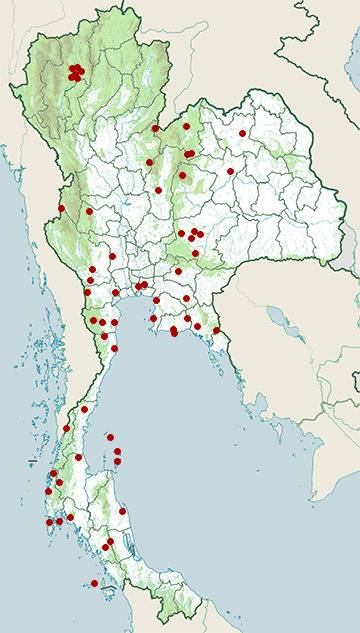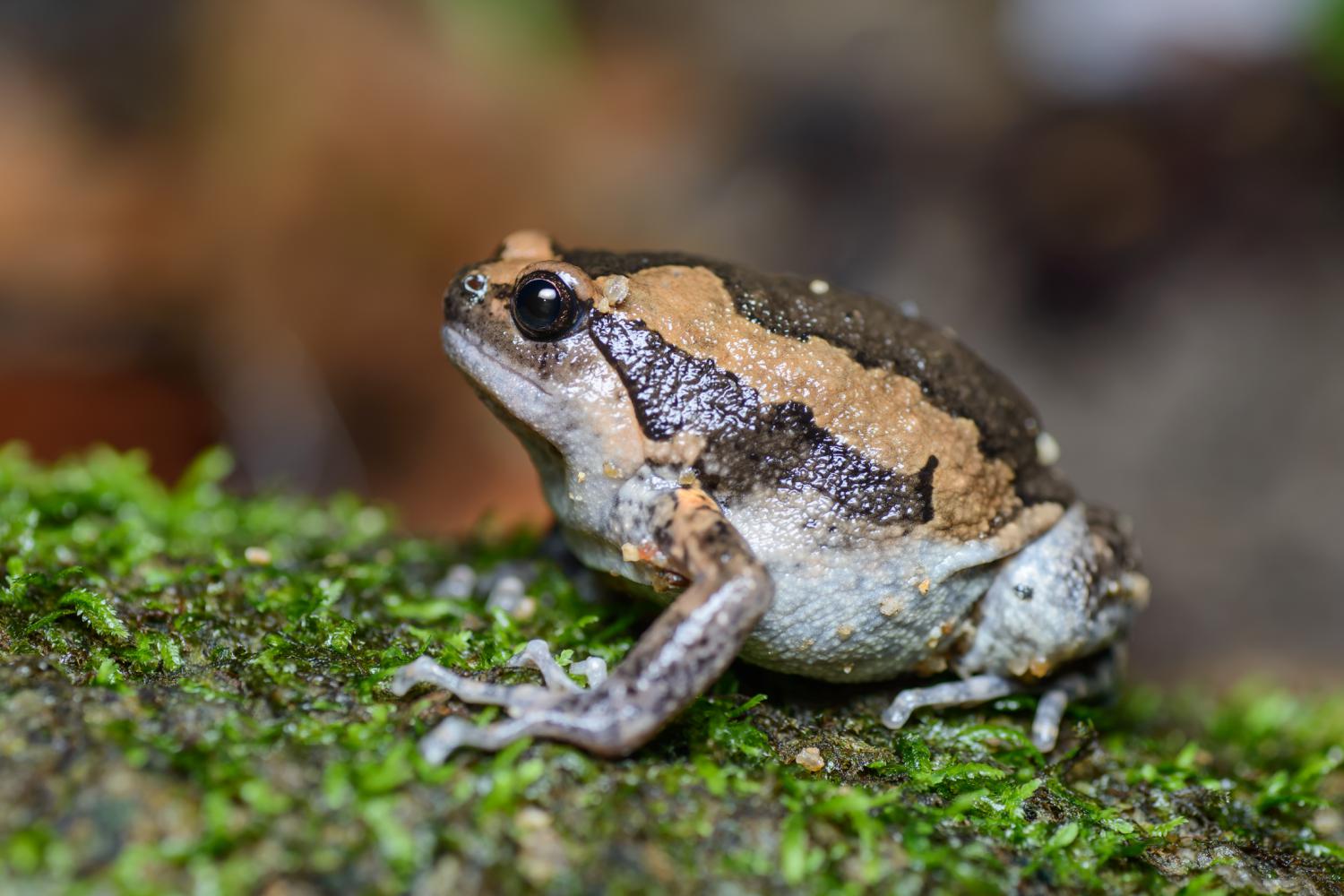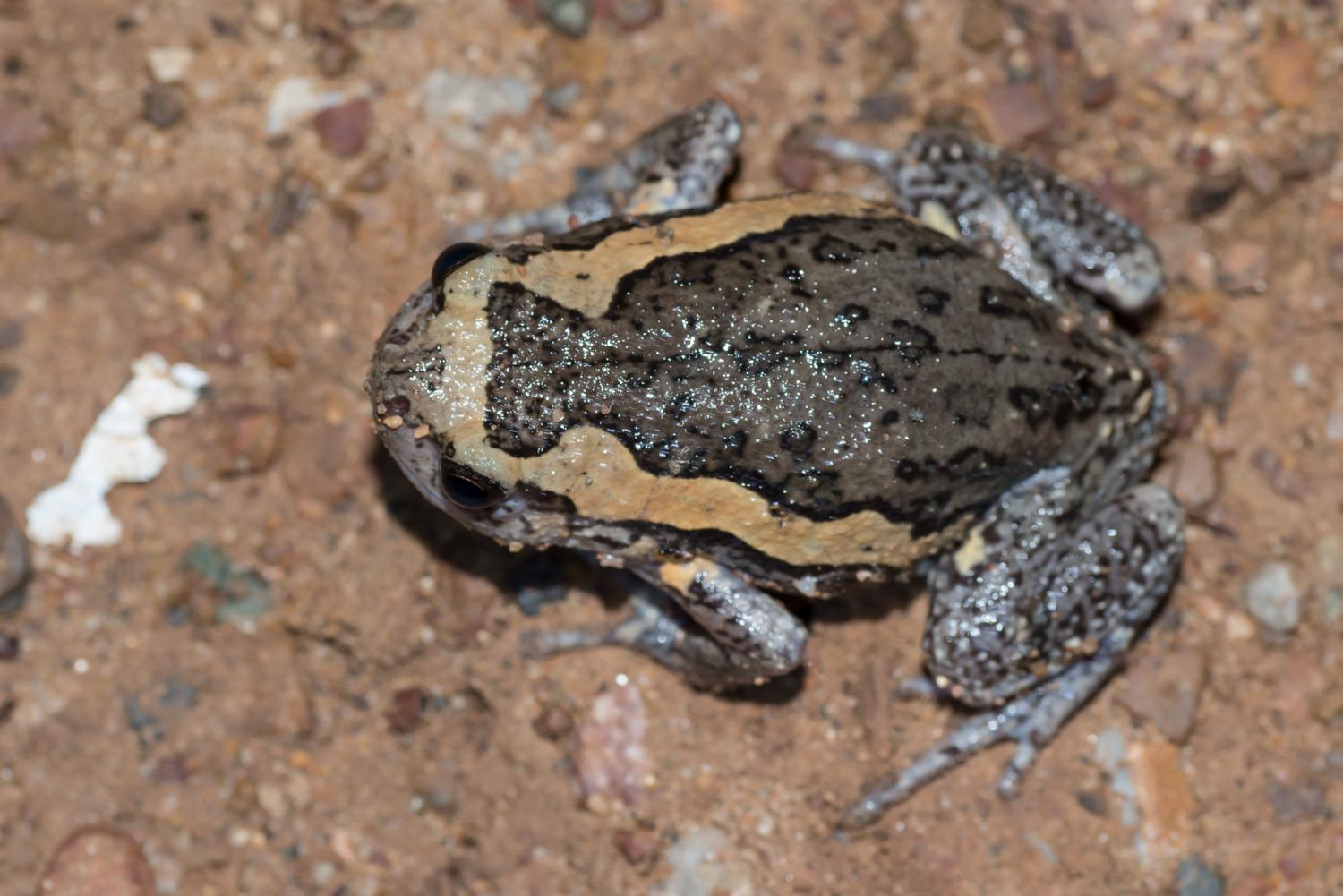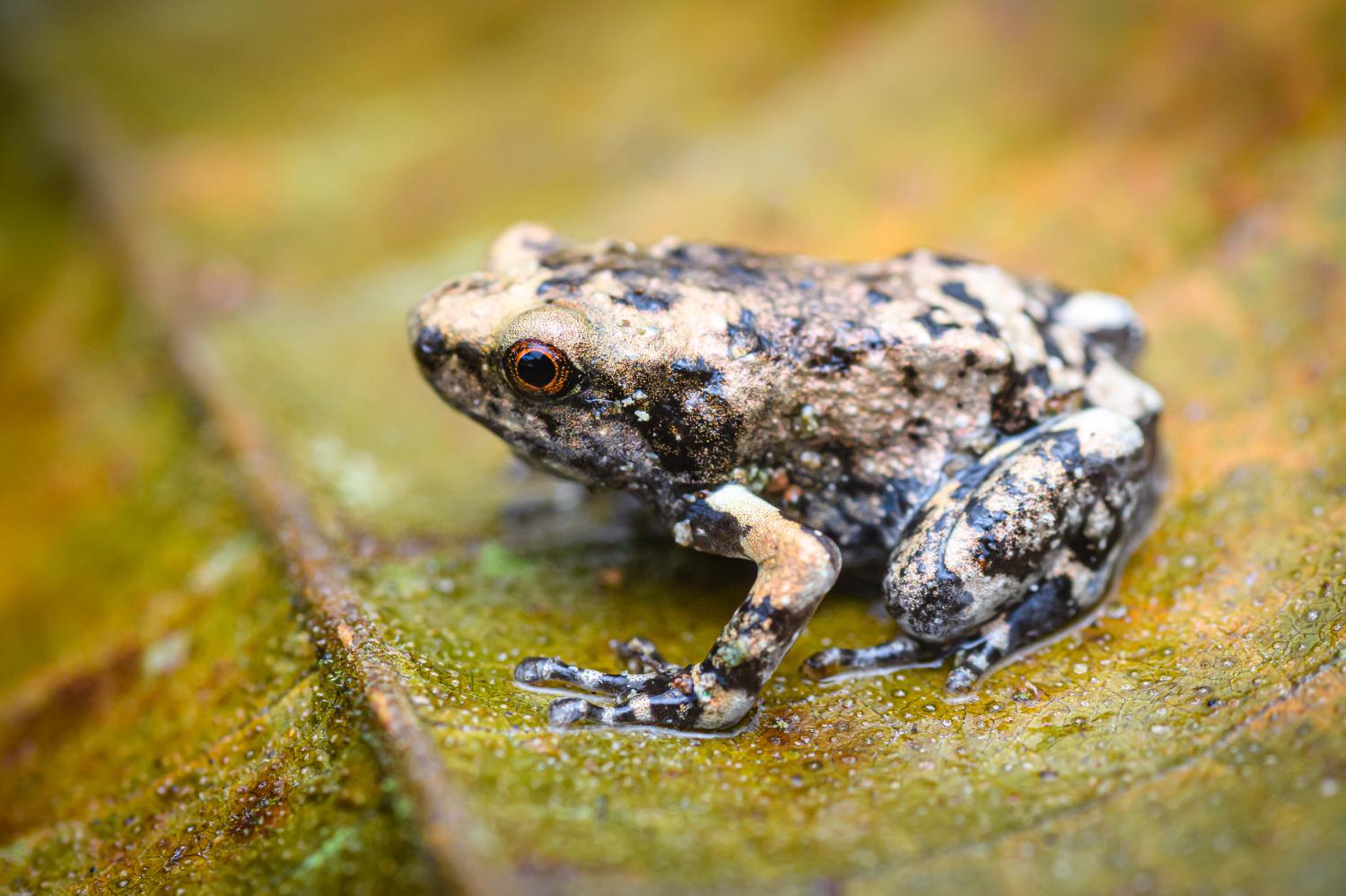Species of Thailand
Banded bullfrog
Kaloula pulchra
John Edward Gray, 1831
In Thai: อึ่งอ่างบ้าน
The banded bullfrog (Kaloula pulchra) is a species of frog in the narrow-mouthed frog family Microhylidae. Native to Southeast Asia, it is also known as the Asian painted frog, digging frog, Malaysian bullfrog, common Asian frog, and painted balloon frog. In the pet trade, it is sometimes called the chubby frog. Adults measure 5.4 to 7.5 cm and have a dark brown back with stripes that vary from copper-brown to salmon pink.
The banded bullfrog lives at low altitudes and is found in both urban and rural settings, as well as in forest habitats. They bury themselves underground during dry periods and emerge after heavy rainfall to emit calls and breed. They feed primarily on ants and termites; predators of adults and tadpoles include snakes, dragonfly larvae, and snails. When threatened, they inflate their lungs and secrete a noxious white substance. The species is prevalent in the pet trade and is a potential invasive species being introduced in Taiwan, the Philippines, Guam, Singapore, Borneo, and Sulawesi.
Taxonomy and etymology
The banded bullfrog was first described in 1831 by the British zoologist John Edward Gray, as Kaloula pulchra ( meaning "beautiful" in Latin). Cantor (1847) described the species under the name Hylaedactylus bivittatus, which was synonymized with K. pulchra by Günther (1858). The subspecies K. p. hainana was described by Gressitt (1938) as having a shorter snout and hind legs compared to the nominate subspecies, K. p. pulchra. A former subspecies in Sri Lanka, originally named K. p. taprobanica by Parker (1934), has since been reclassified as a separate species, Uperodon taprobanicus. Bourret (1942) described a subspecies K. p. macrocephala that is now considered by several authors to be a distinct species, K. macrocephala.
According to Darrel Frost's Amphibian Species of the World, common names for Kaloula pulchra include the Malaysian narrowmouth toad, Asian painted frog, digging frog, painted bullfrog, Malaysian bullfrog, painted burrowing frog, common Asian bullfrog, painted balloon frog, and painted microhylid frog. It is also known as the chubby frog in the pet trade.
Description
The banded bullfrog is medium-sized with a stocky, triangular body and a short snout. Males grow to a snout–vent length (SVL) of 5.4 to 7.0 cm and females are slightly larger, reaching an SVL of 5.7 to 7.5 cm. Other than the slight difference in length, there is very limited sexual dimorphism. They have a body weight of 80 - 120 g. The back is dark brown with stripes that vary from copper-brown to salmon pink, and the abdomen is cream-colored.
Tadpoles are about 0.5 cm long after hatching and reach an SVL of about 1.1 cm at the end of metamorphosis. They have an oval body that is brown or black with a pale belly, a round snout, and a moderately long, tapered tail with yellow speckles and tall fins. The eyes are relatively small and the side of the head, with black or dark gray irises and a golden ring around the pupil. They do not possess any tail filament. During metamorphosis, their eyes increase in size and bulge and they develop slender limbs and digits with rounded tips. The tadpoles metamorphose beginning at two weeks.
Distribution and habitat
The species is native to Southeast Asia. It is common over a range from northeastern India, and Nepal, to southern India and Sri Lanka to southern China (especially Hainan) and Myanmar, and south to the islands of maritime Southeast Asia. Its wide distribution, compared to the related species Kaloula assamensis, has been attributed to its burrowing ability.
The banded bullfrog has been found at elevations between sea level and 750 m above sea level. It can occur in both urban and rural settings, and in forest habitats.
As an invasive species
The banded bullfrog is a potential invasive species. It has been introduced through both the pet trade and maritime transport, and has become established in Taiwan, the Philippines, Guam, Singapore, Borneo, and Sulawesi. Some specimens have been observed in Australia and New Zealand. Its introduction into the Philippines was likely accidental, via contamination of plant nursery materials or stowaways on ships and boats.
Several species, likely introduced through the pet trade, were observed in Florida in 2006 and 2008; however, as of 2011, the population is under control and there is no evidence of reproduction. The frog was observed at an airport in Perth, Australia, and at a cargo port in New Zealand, but no established invasive population has been found in either country as of 2019.
Behaviour and ecology
Breeding is stimulated by heavy monsoon rains, after which the frogs relocate from underground to rain pools or ponds. They are more commonly found on wetter nights, and while they are not reproductively active during dry periods, their gonads remain ripe so that they can mate soon after rainfall. In India, the male frogs call after the monsoon season begins in April or May. The pulses of the calls recorded in India were 28–56 per second with a frequency range of 50–1760 Hz. In Thailand the dominant frequency was 250 Hz (duration 560–600 ms long) and 18–21 pulses per call.
Their form is suited for walking and burrowing rather than jumping. They are able to survive dry conditions by burying themselves in the ground and waiting for rain; the burrowing also helps them avoid predators. When burrowing they dig their way down hindlimb first and use their forelimbs to push themselves several inches under the soil, where they can remain for the duration of the dry season. Banded bullfrogs hide under leaf litter during the daylight hours and eat in the evening. They have been found in trees and have been observed hunting termites in them.
Diet, predators, and parasites
In the wild, the banded bullfrog primarily eats ants and termites. It also feeds on other small invertebrates including flies, crickets, moths, grasshoppers, and earthworms. Its relatively small head and mouth mostly limit its diet to small and slow-moving prey. The feeding cycle from opening of the mouth to closing is about 150 milliseconds and is relatively symmetrical, meaning that the bullfrog spends an equal amount of time extending its tongue and bringing the prey into the mouth. Banded bullfrogs kept as pets can be fed insects such as crickets, mealworms, insect larvae, and beetles.
Snakes such as the kukri snake are predators of adult banded bullfrogs. For eggs and tadpoles, predators include dragonfly larvae and snails such as the golden apple snail. Banded bullfrogs display deimatic behaviour when threatened, greatly inflating their bodies in an attempt to distract or startle predators. By inflating its body and bending its head down, the bullfrog can appear larger than its actual size. It also secretes a noxious white substance through its skin that is distasteful, though non-toxic, to predators. The secretion contains a trypsin inhibitor and can induce hemolysis (rupturing of red blood cells).
Parasites include parasitic worms that have been found in the frog's intestinal mesentery and leeches that attach to the frog's back.
Pet trade
Commonly sold in pet stores, banded bullfrogs thrive in terrariums with substrate choices consisting of peat–soil mixes or moss mixtures. In contrast to the ant and termite diets of wild bullfrogs, captive bullfrogs typically feed on slightly larger insects such as crickets or mealworms.
A survey of internet pet trade listings between 2015 and 2018 in Europe and the United States found that there were three to four times as many offers as requests for the banded bullfrog, with no evidence of captive breeding. In the Philippines, traders collect the frogs locally. Low interest in the Philippine pet trade has been attributed to the bullfrog's muted colours and burrowing behavior. Máximo and colleagues hypothesize that the species has been illegally sold in South America for decades, based on identifications in Argentina during the 1980s and in Brazil in 2020.
Conservation status
The International Union for Conservation of Nature listed the species as least concern due to its extensive distribution, tolerance of a wide range of environments, and predicted large population. In many regions, the banded bullfrog is captured for consumption, but this does not appear to have a substantial impact on its population.
This article uses material from Wikipedia released under the Creative Commons Attribution-Share-Alike Licence 3.0. Eventual photos shown in this page may or may not be from Wikipedia, please see the license details for photos in photo by-lines.
Scientific classification
- Kingdom
- Animalia
- Phylum
- Chordata
- Class
- Amphibia
- Order
- Anura
- Family
- Microhylidae
- Genus
- Kaloula
- Species
- Kaloula pulchra
Common names
- English:
- Banded bullfrog
- Malaysian narrowmouth toad
- Ox frog
- Painted bullfrog
- Painted burrowing frog
- Piebald digging frog
- Thai: อึ่งอ่างบ้าน
Conservation status

Least Concern (IUCN3.1)
Photos
Please help us review our species pages if wrong photos are used or any other details in the page is wrong. We can be reached via our contact us page.
Range Map

- Amphawa District, Samut Songkhram
- Bacho District, Narathiwat
- Ban Na District, Nakhon Nayok
- Ban Na San District, Surat Thani
- Ban Phue District, Udon Thani
- Bang Khae District, Bangkok
- Bang Lamung District, Chonburi
- Bang Na District, Bangkok
- Bang Rachan District, Sing Buri
- Bang Sai District, Phra Nakhon Si Ayutthaya
- Bang Saphan District, Prachuap Khiri Khan
- Betong District, Yala
- Bo Rai District, Trat
- Borabue District, Maha Sarakham
- Cha-uat District, Nakhon Si Thammarat
- Chai Badan District, Lopburi
- Chana District, Songkhla
- Chatuchak District, Bangkok
- Chiang Dao District, Chiang Mai
- Chiang Kham District, Phayao
- Chiang Saen District, Chiang Rai
- Chok Chai District, Nakhon Ratchasima
- Chun District, Phayao
- Damnoen Saduak District, Ratchaburi
- Dan Makham Tia District, Kanchanaburi
- Doi Khun Tan National Park
- Doi Saket District, Chiang Mai
- Hang Chat District, Lampang
- Hang Dong District, Chiang Mai
- Hat Yai District, Songkhla
- Hua Hin District, Prachuap Khiri Khan
- Huai Kha Khaeng Wildlife Sanctuary
- Huai Khwang District, Bangkok
- Kaeng Khoi District, Saraburi
- Kaeng Krachan District, Phetchaburi
- Kaeng Krachan National Park
- Kantharawichai District, Maha Sarakham
- Kapo Waterfall Forest Park
- Kathu District, Phuket
- Kham Thale So District, Nakhon Ratchasima
- Khan Na Yao District, Bangkok
- Khao Banthat Wildlife Sanctuary
- Khao Chamao District, Rayong
- Khao Chamao - Khao Wong National Park
- Khao Laem Ya - Mu Ko Samet National Park
- Khao Luang National Park
- Khao Nang Phanthurat Forest Park
- Khao Sam Roi Yot National Park
- Khao Sok National Park
- Khao Yai Da
- Khao Yai National Park
- Khao Yoi District, Phetchaburi
- Khlong Luang District, Pathum Thani
- Khlong Thom District, Krabi
- Khok Sung District, Sa Kaeo
- Khura Buri District, Phang Nga
- Ko Chang National Park
- Ko Kut District, Trat
- Ko Lanta District, Krabi
- Ko Lipe
- Ko Muk
- Ko Ngai
- Ko Pha Ngan
- Ko Samet
- Ko Samui District, Surat Thani
- Ko Sichang District, Chonburi
- Ko Tao
- Ko Yao District, Phang Nga
- Kra Buri District, Ranong
- Krasang District, Buriram
- Kui Buri District, Prachuap Khiri Khan
- Kui Buri National Park
- Kumphawapi District, Udon Thani
- Laem Sing District, Chanthaburi
- Lam Luk Ka District, Pathum Thani
- Lat Krabang District, Bangkok
- Mae Ping National Park
- Mae Rim District, Chiang Mai
- Mae Sot District, Tak
- Mueang Chiang Mai District, Chiang Mai
- Mueang Chiang Rai District, Chiang Rai
- Mueang Chonburi District, Chonburi
- Mueang Chumphon District, Chumphon
- Mueang Kanchanaburi District, Kanchanaburi
- Mueang Khon Kaen District, Khon Kaen
- Mueang Krabi District, Krabi
- Mueang Lamphun District, Lamphun
- Mueang Loei District, Loei
- Mueang Nakhon Ratchasima District, Nakhon Ratchasima
- Mueang Nakhon Si Thammarat District, Nakhon Si Thammarat
- Mueang Pathum Thani District, Pathum Thani
- Mueang Pattani District, Pattani
- Mueang Phitsanulok District, Phitsanulok
- Mueang Phuket District, Phuket
- Mueang Prachinburi District, Prachinburi
- Mueang Prachuap Khiri Khan District, Prachuap Khiri Khan
- Mueang Samut Songkhram District, Samut Songkhram
- Mueang Sing Buri District, Sing Buri
- Mueang Sukhothai District, Sukhothai
- Mueang Surat Thani District, Surat Thani
- Mueang Surin District, Surin
- Mueang Trang District, Trang
- Mueang Udon Thani District, Udon Thani
- Nam Nao National Park
- Nam Phong National Park
- Ngao Waterfall National Park
- Nong Han District, Udon Thani
- Nong Phai District, Phetchabun
- Nuea Khlong District, Krabi
- Pai District, Mae Hong Son
- Pak Kret District, Nonthaburi
- Pak Phanang District, Nakhon Si Thammarat
- Pak Phayun District, Phatthalung
- Pathio District, Chumphon
- Phanom District, Surat Thani
- Phato District, Chumphon
- Phaya Thai District, Bangkok
- Phayuha Khiri District, Nakhon Sawan
- Phen District, Udon Thani
- Phi Phi Islands
- Phra Khanong District, Bangkok
- Phra Nakhon Si Ayutthaya District, Phra Nakhon Si Ayutthaya
- Phu Khiao Wildlife Sanctuary
- Phu Kradueng District, Loei
- Phu Kradueng National Park
- Phu Sa Dok Bua National Park
- Phu Suan Sai National Park
- Prachantakham District, Prachinburi
- Pran Buri District, Prachuap Khiri Khan
- Prathai District, Nakhon Ratchasima
- Prawet District, Bangkok
- Ramkhamhaeng National Park
- Rat Burana District, Bangkok
- Ratchathewi District, Bangkok
- Ron Phibun District, Nakhon Si Thammarat
- Sai Yok District, Kanchanaburi
- Sakaerat Environmental Research Station
- Sam Roi Yot District, Prachuap Khiri Khan
- San Sai District, Chiang Mai
- Saphan Sung District, Bangkok
- Saraphi District, Chiang Mai
- Sathon District, Bangkok
- Sattahip District, Chonburi
- Sawi District, Chumphon
- Si Racha District, Chonburi
- Si Satchanalai District, Sukhothai
- Sikhio District, Nakhon Ratchasima
- Similan Islands
- Song District, Phrae
- Su-ngai Kolok District, Narathiwat
- Suan Phueng District, Ratchaburi
- Sung Noen District, Nakhon Ratchasima
- Takua Pa District, Phang Nga
- Tarutao National Marine Park
- Tha Chana District, Surat Thani
- Tha Chang District, Sing Buri
- Tha Mai District, Chanthaburi
- Tha Sae District, Chumphon
- Tha Takiap District, Chachoengsao
- Tha Yang District, Phetchaburi
- Thai Mueang District, Phang Nga
- Thalang District, Phuket
- Thanyaburi District, Pathum Thani
- Thap Put District, Phang Nga
- Thap Sakae District, Prachuap Khiri Khan
- Thawi Watthana District, Bangkok
- Thong Pha Phum District, Kanchanaburi
- Thung Salaeng Luang National Park
- Thung Song District, Nakhon Si Thammarat
- Thung Yai Naresuan Wildlife Sanctuary
- U Thong District, Suphan Buri
- Ubolratana District, Khon Kaen
- Wang Chan District, Rayong
- Wiang Kosai National Park
- Wiang Sa District, Nan
- Yan Ta Khao District, Trang
- Yang Talat District, Kalasin






